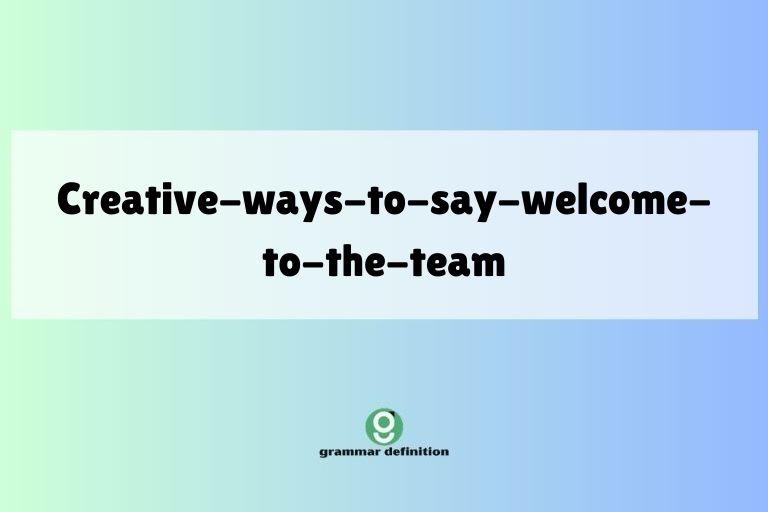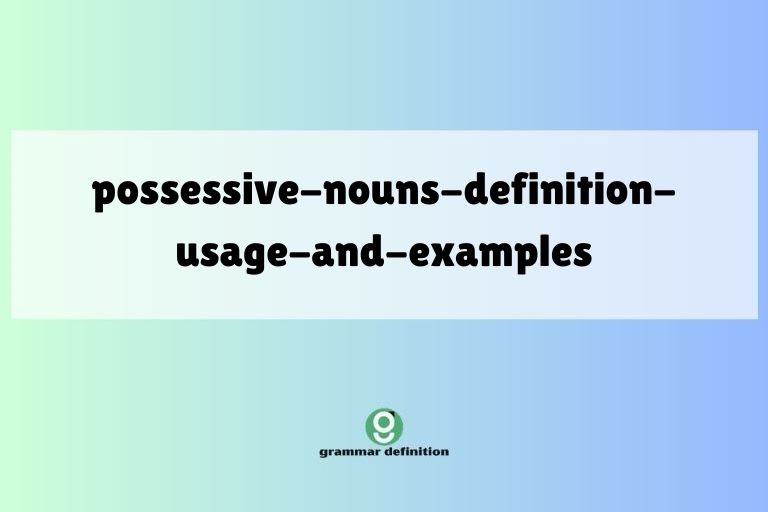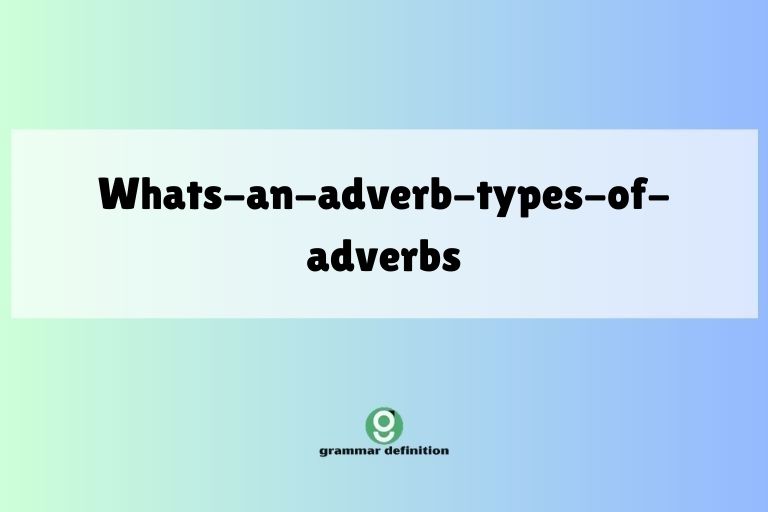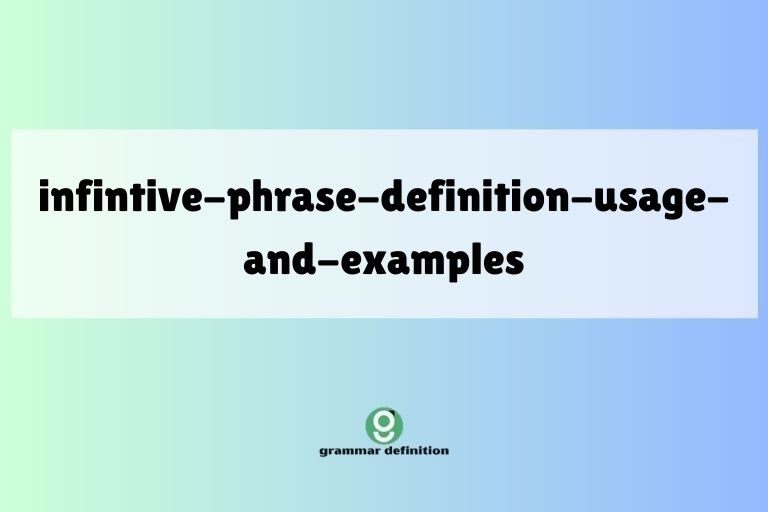Creative Ways to Say “Welcome to the Team”: A Grammar Guide

Welcoming a new team member is a crucial step in fostering a positive and productive work environment. The language we use in these moments can significantly impact how quickly a new colleague feels comfortable, valued, and integrated into the team.
This article explores a variety of creative and grammatically sound ways to express “Welcome to the team,” providing examples, usage rules, and common mistakes to avoid. Understanding these nuances will help you craft messages that are both welcoming and professional, setting the stage for successful collaboration.
This guide is perfect for managers, team leads, HR professionals, and anyone looking to enhance their communication skills in a professional setting.
This article delves into the grammatical structures used in welcome messages, focusing on sentence construction, verb tenses, and appropriate vocabulary. We will examine different tones and styles, from formal to informal, and how to adapt your language to suit the company culture and the new team member’s role.
By mastering these techniques, you can confidently create welcoming messages that leave a lasting positive impression.
Table of Contents
- Introduction
- Definition: Welcoming Expressions
- Structural Breakdown of Welcome Phrases
- Types and Categories of Welcome Messages
- Examples of Welcome Phrases
- Usage Rules for Effective Welcomes
- Common Mistakes in Welcome Messages
- Practice Exercises
- Advanced Topics: Nuances in Welcoming
- FAQ: Frequently Asked Questions
- Conclusion
Definition: Welcoming Expressions
Welcoming expressions are phrases and sentences used to greet and integrate a new individual into a group, team, or organization. These expressions serve the primary function of making the newcomer feel accepted, valued, and comfortable in their new environment.
The effectiveness of a welcoming expression lies in its ability to convey warmth, support, and a sense of belonging. These expressions can range from simple greetings to more elaborate statements of anticipation and support.
From a grammatical perspective, welcoming expressions often involve the use of positive and inclusive language. They frequently incorporate active voice to convey enthusiasm and direct engagement.
The choice of verb tense is also crucial, with present and future tenses commonly used to express ongoing support and future collaboration. The context and audience play a significant role in determining the appropriate tone and level of formality.
Structural Breakdown of Welcome Phrases
Welcome phrases, while seemingly simple, often adhere to specific structural patterns. Understanding these patterns can help you create more effective and grammatically sound welcome messages.
Common structures include:
- Greeting + Statement of Welcome: This structure begins with a simple greeting (e.g., “Hello,” “Hi,” “Good morning”) followed by a direct statement of welcome (e.g., “Welcome to the team!”).
- Statement of Enthusiasm + Welcome: This pattern starts with an expression of excitement or anticipation (e.g., “We’re thrilled to have you!”) before extending the welcome (e.g., “Welcome aboard!”).
- Welcome + Reason for Enthusiasm: This structure leads with the welcome and then provides a reason for the positive sentiment (e.g., “Welcome to the company; we’re excited about your expertise in data analytics.”).
- Question + Welcome (Indirect): This approach uses a question to indirectly welcome the new member (e.g., “Ready to make a difference? Welcome to the team!”).
The verb tenses commonly used in welcome phrases include the simple present (e.g., “We are happy to have you”) and the future tense (e.g., “We look forward to working with you”). The choice of pronouns is also important, with inclusive pronouns like “we” and “our” used to foster a sense of belonging.
The use of adjectives and adverbs can further enhance the impact of the welcome message, adding warmth and enthusiasm (e.g., “We are incredibly excited to welcome you!”).
Types and Categories of Welcome Messages
Welcome messages can be categorized based on their tone, level of formality, and specific purpose. Understanding these categories can help you tailor your welcome message to the specific context and audience.
Formal Welcomes
Formal welcomes are typically used in professional settings, particularly in larger organizations or when addressing a new employee in a senior position. These welcomes often emphasize the company’s values, goals, and expectations.
The language used is typically more structured and less personal.
Informal Welcomes
Informal welcomes are more common in smaller teams or organizations with a relaxed culture. These welcomes tend to be more personal and conversational, often using humor and casual language to create a friendly atmosphere.
Enthusiastic Welcomes
Enthusiastic welcomes express a high level of excitement and anticipation. These welcomes often use exclamation points, strong adjectives, and dynamic verbs to convey energy and positivity.
This type of welcome can be particularly effective in boosting morale and creating a sense of excitement around the new team member’s arrival.
Collaborative Welcomes
Collaborative welcomes emphasize the importance of teamwork and shared goals. These welcomes often highlight the new team member’s potential contributions and the opportunities for collaboration and mutual support.
This type of welcome is particularly effective in fostering a sense of belonging and shared purpose.
Personalized Welcomes
Personalized welcomes are tailored to the specific individual and their unique skills, experiences, or interests. These welcomes demonstrate that the team has taken the time to learn about the new member and is genuinely excited to have them on board.
Personalized welcomes can be particularly impactful in making the new employee feel valued and appreciated.
Examples of Welcome Phrases
The following sections provide a variety of examples of welcome phrases, organized by category. These examples illustrate the different tones, styles, and structural patterns discussed above.
Formal Welcome Examples
Formal welcome messages are often used in professional settings and emphasize respect and adherence to company standards. They are typically used when welcoming new employees to larger organizations or when addressing individuals in senior positions.
The following table provides a wide array of formal welcome examples.
| Example | Notes |
|---|---|
| “On behalf of the entire organization, we extend a warm welcome to you.” | Classic and widely applicable. |
| “We are pleased to welcome you to [Company Name] and look forward to your contributions.” | Highlights the company and future contributions. |
| “It is with great pleasure that we welcome you to our team. We trust that your skills and experience will be a valuable asset.” | Emphasizes skills and experience. |
| “We officially welcome you to [Department Name]. We are confident that you will quickly integrate into our work environment.” | Specific to the department and emphasizes integration. |
| “The management team extends its sincere welcome to you. We anticipate a productive and successful collaboration.” | Highlights management’s welcome and anticipates success. |
| “We are delighted to have you join our company. We believe your expertise will greatly benefit our ongoing projects.” | Highlights expertise and its benefits. |
| “Please accept our formal welcome to the team. We are eager to see the positive impact you will have on our operations.” | Emphasizes positive impact. |
| “It is our honor to welcome you aboard. We are committed to providing you with the resources and support you need to succeed.” | Highlights support and resources. |
| “We extend a cordial welcome to you and wish you a long and fulfilling career with our organization.” | Wishes a long and fulfilling career. |
| “We formally welcome you to the [Project Name] team. We are excited to work alongside you to achieve our goals.” | Specific to the project and emphasizes teamwork. |
| “We are pleased to announce and formally welcome you as the newest member of our esteemed team.” | Highlights the esteem of the team. |
| “On behalf of the board of directors, I extend a formal and hearty welcome to our company.” | Includes the board of directors. |
| “The entire staff joins me in offering you a sincere and formal welcome to your new role.” | Includes the entire staff. |
| “It is a privilege to formally welcome you to our organization. We anticipate great achievements together.” | Anticipates great achievements. |
| “We formally acknowledge and welcome your arrival, trusting that your contributions will enhance our mission.” | Highlights contributions to the mission. |
| “The senior leadership team formally welcomes you to [Company Name], anticipating your valuable input.” | Acknowledges senior leadership and anticipates input. |
| “We officially extend our warmest welcome to you, with the expectation of a fruitful and collaborative partnership.” | Highlights expectations for partnership. |
| “We are honored to formally welcome you to our ranks and look forward to your innovative ideas.” | Highlights honor and innovative ideas. |
| “The human resources department formally welcomes you, ensuring all necessary support for your successful onboarding.” | Highlights HR support and onboarding. |
| “We formally welcome you, confident that your expertise will significantly contribute to our strategic objectives.” | Highlights contribution to strategic objectives. |
| “The executive team formally welcomes you to the company, recognizing your potential to drive our future success.” | Highlights the executive team and potential for future success. |
| “We formally welcome you to the company, and we are committed to providing a supportive and inclusive work environment.” | Highlights commitment to a supportive environment. |
| “We are pleased to formally welcome you to the team, and we value the unique perspective you bring.” | Highlights the value of unique perspectives. |
| “The organization formally welcomes you, and we look forward to your contributions to our shared mission.” | Highlights contributions to the shared mission. |
Informal Welcome Examples
Informal welcomes are common in relaxed work environments or smaller teams. They create a friendly and approachable atmosphere.
The following examples illustrate how to extend a welcome in a more casual manner.
| Example | Notes |
|---|---|
| “Hey [Name], welcome aboard! Glad to have you.” | Uses a casual greeting and expresses simple pleasure. |
| “Welcome to the team! We’re all super excited to have you here.” | Expresses excitement. |
| “So glad you’re here! Welcome to the crazy bunch.” | Humorous and self-deprecating. |
| “Welcome! Feel free to ask any questions – we’re here to help.” | Encourages questions and offers help. |
| “Hey [Name], welcome! Looking forward to working with you.” | Simple and friendly. |
| “Welcome to the team! Let’s grab coffee sometime soon.” | Suggests a casual get-together. |
| “Glad to have you with us! Welcome, and don’t be a stranger.” | Encourages interaction. |
| “Welcome! We’re all looking forward to seeing what you bring to the table.” | Highlights anticipation. |
| “Hey [Name], welcome! Hope you settle in quickly.” | Wishes for a quick adjustment. |
| “Welcome to the team! We’re a bit quirky, but we’re fun.” | Acknowledges quirks and emphasizes fun. |
| “Welcome! Jump right in – we’re always busy!” | Encourages immediate involvement. |
| “Hey [Name], welcome! Make yourself at home.” | Encourages comfort and relaxation. |
| “Welcome aboard! We’re stoked to have you.” | Uses slang to express excitement. |
| “Welcome to the team! You’ll fit right in.” | Expresses confidence in fitting in. |
| “Hey [Name], welcome! Get ready for some fun.” | Promises a fun experience. |
| “Welcome! We’re all excited to see what you can do.” | Expresses excitement about potential contributions. |
| “Welcome to the team! Don’t hesitate to reach out if you need anything.” | Offers support and encourages communication. |
| “Hey [Name], welcome! It’s great to finally have you on board.” | Expresses relief and satisfaction. |
| “Welcome! We’re a friendly bunch, so feel free to mingle.” | Encourages socialization. |
| “Welcome to the team! We’re all looking forward to learning from you.” | Expresses a desire to learn from the new member. |
| “Hey [Name], welcome! Let’s make some magic happen.” | Encourages creativity and collaboration. |
| “Welcome! We’re like a family here – just a little dysfunctional.” | Uses humor to describe the team dynamic. |
| “Welcome to the team! Prepare for awesomeness!” | Promises an awesome experience. |
| “Hey [Name], welcome! We’re thrilled to have you join our little circus.” | Uses a fun analogy to describe the team. |
Enthusiastic Welcome Examples
Enthusiastic welcomes are filled with excitement and energy, making the new member feel especially valued. These messages often use exclamation points and strong adjectives.
Here are some examples:
| Example | Notes |
|---|---|
| “A huge welcome to the team! We’re absolutely thrilled to have you!” | Uses “huge” and “thrilled” to convey excitement. |
| “Welcome aboard! We’re incredibly excited to see what you’ll accomplish!” | Highlights potential accomplishments. |
| “Yay! Welcome to the team! Get ready for an amazing journey!” | Uses “Yay!” and promises an “amazing journey.” |
| “We’re bursting with excitement to welcome you! Welcome, welcome, welcome!” | Repetitive welcome emphasizes enthusiasm. |
| “Welcome to the family! We’re so pumped to have you join us!” | Uses “pumped” and refers to the team as “family.” |
| “A massive welcome to the team! We’re absolutely delighted to have you on board!” | Uses “massive” and “delighted.” |
| “Welcome! We’re over the moon to have you with us! Let’s do great things!” | Uses “over the moon” and encourages achievement. |
| “The whole team is ecstatic to welcome you! Welcome, and get ready to rock!” | Uses “ecstatic” and encourages high performance. |
| “Welcome! We’re beyond excited to have you! Prepare for an adventure!” | Uses “beyond excited” and promises an “adventure.” |
| “A super enthusiastic welcome to the team! Let’s make some magic together!” | Encourages collaboration and creativity. |
| “Welcome! We’re so incredibly happy to have you join our awesome team!” | Highlights happiness and the team’s awesomeness. |
| “A huge, warm, and enthusiastic welcome to the team! We’re thrilled!” | Combines multiple positive adjectives. |
| “Welcome aboard! This is going to be epic! We’re so ready for you!” | Promises an “epic” experience. |
| “We couldn’t be more excited to welcome you! Let’s make some waves!” | Encourages making an impact. |
| “Welcome to the team! We’re jumping for joy to have you with us!” | Uses a vivid expression of excitement. |
| “A tremendously enthusiastic welcome! Get ready to be amazed!” | Promises an amazing experience. |
| “Welcome! We’re absolutely buzzing with excitement to have you here!” | Uses “buzzing with excitement.” |
| “An overwhelmingly enthusiastic welcome to our newest superstar! Welcome!” | Refers to the new member as a “superstar.” |
| “Welcome to the team! We’re doing a happy dance to celebrate your arrival!” | Uses a playful expression of celebration. |
| “A phenomenally enthusiastic welcome awaits you! Let’s achieve greatness together!” | Encourages achieving greatness. |
| “Welcome! We’re absolutely thrilled to have you join our dynamic team!” | Highlights the team’s dynamism. |
| “A fantastically enthusiastic welcome to the best team ever! Welcome aboard!” | Claims the team is the “best ever.” |
| “Welcome! We’re incredibly pumped to have you here! Let’s make history!” | Encourages making history. |
| “A spectacularly enthusiastic welcome to our newest team member! Welcome!” | Uses “spectacularly enthusiastic.” |
Collaborative Welcome Examples
Collaborative welcomes emphasize teamwork and shared goals. They make the new team member feel like an integral part of the group.
Consider these examples:
| Example | Notes |
|---|---|
| “Welcome to the team! We’re looking forward to collaborating with you on exciting projects.” | Highlights collaboration on projects. |
| “We’re thrilled to have you join us! Let’s work together to achieve our goals.” | Emphasizes working together towards goals. |
| “Welcome aboard! We believe your skills will be a great asset to our collaborative efforts.” | Highlights the value of the new member’s skills. |
| “Welcome to the team! We’re excited to share ideas and work together to innovate.” | Encourages sharing ideas and innovation. |
| “We’re delighted to welcome you! Let’s combine our strengths and create something amazing.” | Encourages combining strengths. |
| “Welcome to the team! We’re eager to learn from your experiences and collaborate on future endeavors.” | Expresses a desire to learn and collaborate. |
| “We’re excited to have you join our collaborative environment. Welcome aboard!” | Highlights the collaborative environment. |
| “Welcome to the team! We value teamwork and are looking forward to your contributions.” | Emphasizes the value of teamwork. |
| “We’re thrilled to welcome you! Let’s pool our talents and achieve great things together.” | Encourages pooling talents. |
| “Welcome to the team! We’re all about collaboration and mutual support.” | Highlights collaboration and support. |
| “We’re excited to have you join our team! Let’s build something amazing together.” | Encourages building something amazing. |
| “Welcome aboard! Your unique perspective will be invaluable to our collaborative projects.” | Highlights the value of unique perspectives. |
| “Welcome to the team! We’re looking forward to brainstorming and innovating with you.” | Encourages brainstorming and innovation. |
| “We’re delighted to welcome you! Let’s work together seamlessly to achieve our objectives.” | Encourages seamless collaboration. |
| “Welcome to the team! We believe in the power of collaboration and are excited to have you.” | Emphasizes the power of collaboration. |
| “We’re excited to have you join our collaborative journey! Welcome aboard!” | Highlights the collaborative journey. |
| “Welcome to the team! We’re looking forward to sharing knowledge and growing together.” | Encourages knowledge sharing and growth. |
| “We’re thrilled to welcome you! Let’s create a collaborative synergy that drives success.” | Encourages creating a collaborative synergy. |
| “Welcome to the team! We value open communication and collaborative problem-solving.” | Emphasizes open communication and problem-solving. |
| “We’re excited to have you join our collaborative family! Welcome aboard!” | Refers to the team as a collaborative family. |
Personalized Welcome Examples
Personalized welcomes show that you’ve taken the time to learn about the new team member. These messages are more impactful and make the individual feel truly valued.
Here are some examples:
| Example | Notes |
|---|---|
| “Welcome to the team, [Name]! We know your expertise in [Specific Skill] will be a great asset.” | Mentions a specific skill. |
| “We’re so excited to have you, [Name]! Your background in [Previous Company/Industry] is impressive.” | Refers to previous experience. |
| “Welcome aboard, [Name]! We heard you’re passionate about [Hobby/Interest], we have a team that does that too!” | Connects on a personal level with a hobby. |
| “Welcome to the team, [Name]! We’re looking forward to your insights on [Specific Project/Area].” | Highlights specific project or area of expertise. |
| “We’re thrilled to have you, [Name]! Your experience with [Specific Software/Tool] will be invaluable.” | Mentions specific software or tool expertise. |
| “Welcome aboard, [Name]! We know you’re a big fan of [Sports Team/Activity], so we’ll have to catch a game together.” | Connects through sports or activities. |
| “Welcome to the team, [Name]! We’re excited to see how your innovative ideas can enhance our [Specific Department/Process].” | Highlights innovative ideas and their impact. |
| “We’re so happy to have you, [Name]! Your experience in [Specific Region/Market] will be incredibly valuable to our expansion efforts.” | Highlights experience in a specific region or market. |
| “Welcome aboard, [Name]! We heard you’re a master of [Specific Language/Coding Skill], which will be a great asset to our projects.” | Mentions language or coding skills. |
| “Welcome to the team, [Name]! We’re looking forward to your contributions to our [Specific Initiative/Goal].” | Highlights contributions to a specific initiative or goal. |
| “We’re thrilled to have you, [Name]! Your expertise in [Specific Methodology/Framework] will be invaluable to our team.” | Highlights expertise in methodology or framework. |
| “Welcome aboard, [Name]! We know you’re passionate about [Specific Cause/Charity], and we admire your commitment.” | Connects through a shared passion for a cause or charity. |
| “Welcome to the team, [Name]! We’re excited to see how your skills in [Specific Design/Creative Area] will enhance our projects.” | Highlights skills in a design or creative area. |
| “We’re so happy to have you, [Name]! Your background in [Specific Research/Academic Field] will bring unique insights to our team.” | Highlights background in research or academic field. |
| “Welcome aboard, [Name]! We heard you’re an expert in [Specific Marketing/Sales Strategy], which will be a great asset to our efforts.” | Mentions expertise in marketing or sales strategy. |
| “Welcome to the team, [Name]! We’re looking forward to your insights on [Specific Industry Trend/Technology].” | Highlights insights on industry trends or technology. |
| “We’re thrilled to have you, [Name]! Your experience with [Specific Customer/Client Type] will be incredibly valuable to our customer relations.” | Highlights experience with a specific customer or client type. |
| “Welcome aboard, [Name]! We know you’re passionate about [Specific Innovation/Project], and we’re excited to see your contributions.” | Connects through a shared passion for innovation or a project. |
| “Welcome to the team, [Name]! We’re excited to see how your skills in [Specific Communication/Presentation Style] will enhance our team dynamics.” | Highlights skills in communication or presentation style. |
| “We’re so happy to have you, [Name]! Your background in [Specific International/Global Market] will be a great asset to our global expansion.” | Highlights background in an international or global market. |
Usage Rules for Effective Welcomes
Crafting effective welcome messages involves more than just choosing the right words; it also requires adhering to certain usage rules to ensure clarity, appropriateness, and impact. These rules encompass tone, grammar, and cultural sensitivity.
Tone and Appropriateness
The tone of your welcome message should align with the company culture and the new team member’s role. A formal welcome is appropriate for senior executives or in organizations with a hierarchical structure, while an informal welcome is suitable for smaller teams or relaxed work environments.
Avoid humor that could be misinterpreted or offensive, and always maintain a professional demeanor.
Consider the context of the welcome. Is it a public announcement, a private email, or a face-to-face greeting?
The level of formality and personalization should be adjusted accordingly. For example, a public announcement might require a more formal tone, while a private email allows for a more personal touch.
Grammar and Syntax Considerations
Ensure that your welcome message is grammatically correct and uses proper syntax. This not only enhances clarity but also reflects professionalism.
Pay attention to verb tenses, subject-verb agreement, and pronoun usage. Avoid slang or jargon that might be unfamiliar to the new team member.
Use active voice to convey enthusiasm and direct engagement. For example, “We are excited to welcome you” is more impactful than “You are welcomed by us.” Keep your sentences concise and easy to understand.
Avoid overly complex sentence structures that could confuse the reader.
Cultural Sensitivity
Be mindful of cultural differences when crafting your welcome message. Avoid idioms or expressions that might not translate well or could be offensive in certain cultures.
Use inclusive language that respects diversity and avoids stereotypes. If the new team member is from a different cultural background, consider researching their culture to better understand their communication preferences.
Be aware of potential language barriers. If the new team member is not a native English speaker, use clear and simple language.
Avoid using slang or jargon that might be difficult to understand. Consider providing translations of key terms or phrases if necessary.
Common Mistakes in Welcome Messages
Even with the best intentions, it’s easy to make mistakes in welcome messages. Here are some common errors to avoid:
- Using overly casual language in a formal setting: Incorrect: “Hey dude, welcome aboard!” Correct: “We extend a warm welcome to you.”
- Grammatical errors: Incorrect: “Welcome to the team, we are excited to had you.” Correct: “Welcome to the team; we are excited to have you.”
- Including irrelevant or personal information: Incorrect: “Welcome to the team! I had pizza last night.” Correct: “Welcome to the team! We’re glad to have you.”
- Forgetting to proofread: A typo or grammatical error can undermine the message’s impact. Always double-check your writing.
- Failing to personalize the message: A generic welcome can feel impersonal and insincere. Try to add a personal touch whenever possible.
It’s also important to avoid making assumptions about the new team member’s skills, experience, or interests. Stick to objective facts and avoid making subjective judgments.
Be inclusive and welcoming to everyone, regardless of their background or identity.
Practice Exercises
Test your understanding with these practice exercises. Choose the best welcome phrase for each scenario.
| Question | Options | Answer |
|---|---|---|
| 1. You’re welcoming a senior executive to a large corporation. | a) “Hey, welcome!” b) “We extend a formal welcome to you.” c) “Glad to have you!” | b) “We extend a formal welcome to you.” |
| 2. You’re welcoming a new team member to a small, relaxed startup. | a) “Welcome aboard! Let’s grab coffee.” b) “It is our honor to welcome you.” c) “The management team welcomes you.” | a) “Welcome aboard! Let’s grab coffee.” |
| 3. You want to express enthusiastic excitement. | a) “Welcome.” b) “We’re thrilled to have you!” c) “Please join us.” | b) “We’re thrilled to have you!” |
| 4. You want to emphasize teamwork and collaboration. | a) “Welcome; we’re looking forward to your contributions.” b) “Hey, welcome!” c) “Glad you’re here.” | a) “Welcome; we’re looking forward to your contributions.” |
| 5. You know the new team member is an expert in a specific skill. | a) “Welcome, we know your skills will be useful.” b) “Welcome, [Name]! We know your expertise in [Skill] will be a great asset.” c) “Welcome, hope you like it here.” | b) “Welcome, [Name]! We know your expertise in [Skill] will be a great asset.” |
| 6. Which phrase is the most grammatically correct? | a) “Welcome to the team, we excited!” b) “Welcome to the team, we are excite!” c) “Welcome to the team; we are excited!” | c) “Welcome to the team; we are excited!” |
| 7. You are welcoming a new member who is not a native English speaker. What should you avoid? | a) Clear and simple language b) Slang and Jargon c) Positive and inclusive language | b) Slang and Jargon |
| 8. Which welcome message is most inclusive? | a) “Welcome aboard! Hope you fit in.” b) “Welcome to the team! We’re excited to have you.” c) “Welcome, glad to have another [demographic].” | b) “Welcome to the team! We’re excited to have you
.” |
Advanced Topics: Nuances in Welcoming
Beyond the basics, there are subtle nuances that can elevate your welcome messages from good to exceptional. These involve understanding the psychological impact of your words and tailoring your message to the individual’s personality and expectations.
Psychological Impact: A well-crafted welcome can reduce anxiety and increase a new team member’s sense of belonging. Use positive affirmations and expressions of confidence to boost their self-esteem and encourage them to embrace their new role. For example, instead of saying “We hope you’ll fit in,” say “We’re confident you’ll quickly become an integral part of our team.”
Personality and Expectations: Consider the new team member’s personality and expectations. Are they introverted or extroverted? Do they prefer detailed instructions or more autonomy? Tailor your welcome message to align with their preferences. For example, if the new team member is introverted, avoid overwhelming them with too much information or social events. Instead, offer them a quiet space to acclimate and gradually introduce them to the team.
Long-Term Integration: A welcome message is just the first step in a long-term integration process. Follow up with regular check-ins, provide opportunities for training and development, and encourage ongoing communication and feedback. Create a supportive and inclusive environment where the new team member feels valued and empowered to succeed.
FAQ: Frequently Asked Questions
Q: How formal should my welcome message be?
A: The formality of your welcome message should align with the company culture and the new team member’s role. Senior executives and hierarchical organizations typically require more formal welcomes, while smaller teams and relaxed work environments allow for more informal messages.
Q: What if I don’t know the new team member’s interests or skills?
A: If you’re unsure about the new team member’s interests or skills, focus on general expressions of welcome and support. You can say something like, “We’re excited to have you join our team and look forward to learning more about your background and experience.”
Q: How can I make a virtual welcome more personal?
A: To make a virtual welcome more personal, consider including a video message, sending a small gift, or scheduling a virtual coffee break with the team. Use the new team member’s name and refer to specific details from their resume or LinkedIn profile to show that you’ve done your research.
Q: What should I do if the new team member is from a different cultural background?
A: If the new team member is from a different cultural background, be mindful of cultural differences and avoid idioms or expressions that might not translate well. Use clear and simple language, and consider providing translations of key terms or phrases if necessary.
Q: How important is it to follow up after the initial welcome message?
A: Following up after the initial welcome message is crucial for long-term integration. Schedule regular check-ins, provide opportunities for training and development, and encourage ongoing communication and feedback.
This will help the new team member feel valued and supported.
Conclusion
Crafting effective welcome messages is an art that combines grammatical precision, cultural sensitivity, and a genuine desire to make the new team member feel valued. By understanding the structural patterns, types, and usage rules discussed in this article, you can create welcome messages that are both welcoming and professional.
Remember to tailor your message to the specific context and audience, and always strive to create a positive and inclusive environment. A well-crafted welcome message is not just a formality; it’s an investment in the success and well-being of your team.






